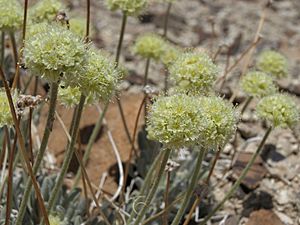Eriogonum tiehmii facts for kids
Quick facts for kids Eriogonum tiehmii |
|
|---|---|
 |
|
| Conservation status | |
| Scientific classification | |
| Genus: |
Eriogonum
|
| Species: |
tiehmii
|
Eriogonum tiehmii, known as Tiehm's buckwheat, is a species of flowering plant endemic to the Silver Peak Range of Esmeralda County, Nevada in the United States. Its only known population is at high risk of destruction due to proposed mining activities by Ioneer, and a significant portion of the population was destroyed in 2020.
Taxonomy
It was first formally named by American botanist James L. Reveal in 1985 in The Great Basin Naturalist. Reveal named the plant for Arnold "Jerry" Tiehm who first collected the species in 1983.
Description
Eriogonum tiehmii is a small, perennial herbaceous plant, growing about 30 cm (12 in) across and up to 16 cm (6 in) tall with blue-grey leaves. The leaves are 1 to 2 cm (0.4 to 0.8 in) long and 5 to 8 mm (0.2 to 0.3 in) across with white or grey hairs on both surfaces, sometimes losing the hairs on the upper surface as it ages.
Conservation status
Tiehm's buckwheat is considered critically imperiled ("at very high risk of extinction or elimination") due to its small population and threat from mining activities. Mining exploration has increased the prevalence of invasive species in its habitat. As of 2020[update], a planned lithium mine by Ioneer is expected to destroy approximately 50–70% of the known population. There have been efforts by conservation groups to federally protect the species and block mining exploration in its habitat.
Between July and September 2020, over 17,000 plants, or over 40% of the population, were wiped out with massive damage to the habitat. Conservation biologists at the University of Nevada, Reno, land management agencies, and Ioneer, theorize that the damage was caused by burrowing rodents, supported by evidence from wildlife surveys and game cameras. However, other groups like the Center for Biological Diversity and Eriogonum researcher Benjamin Grady disagree, and instead theorize that systematic, targeted vandalism was the cause of the losses. Subsequent surveys have noted similar damage to storage organs in nearby desert plants, presumably caused by rodents seeking water in an exceptionally dry year. This has prompted calls for increased protection of the plants, rehabilitation of the affected area, and a further block on any exploration in the area.


